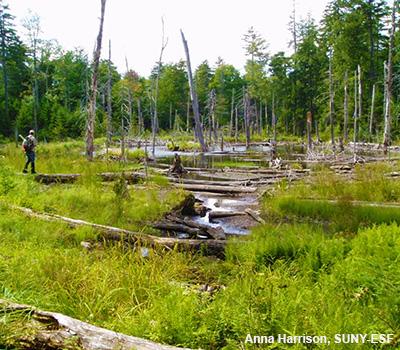Quantifying Beaver Impacts on Adirondack Forest Communities at a Landscape Scale

Re-establishment of beaver throughout the northeastern United States following cessation of widespread trapping since the 19th century is one of the least-studied influences on biodiversity, productivity, and ecosystem function of the Northern Forest. Beaver serve as “ecosystem engineers” by harvesting trees for food and material to create dams and ponds.
NSRC researchers quantified beaver foraging impacts on forest composition and structure at the Huntington Wildlife Forest in New York’s Adirondack Mountains. They delineated beaver forage areas using GPS and geospatial methods and conducted vegetation surveys along waterbodies colonized by beaver. Researchers also analyzed relationships between bird communities and habitat in beaver areas, comparing bird counts in beaver sites to areas of unaltered forest and riparian habitat.
Beaver foraging showed a strong preference for stems 2-5 cm in diameter and for small-diameter trees such as striped maple. High densities of multi-stemmed American beech near pond edges indicated an opportunistic foraging pattern and long-term structural effect on stands dominated by beech. Woody regeneration, dominated by maple seedlings, was greatest near the beaver ponds, where harvesting was most intense, and light penetration greatest. The number of bird species and families represented at beaver sites was higher than at unaltered forest or riparian sites and was positively related to the complexity of understory vegetation structure. Forest openings and ponds resulting from beaver activity increase habitat diversity through greater tree canopy complexity, edge environments, light penetration, and nutrient cycling. In the Northern Forest, where other sources of disturbance such as fire and floods have decreased, beaver disturbance is considered critical to maintaining biodiversity.
